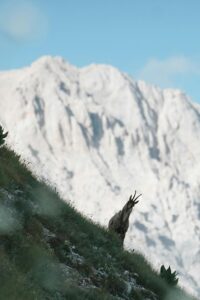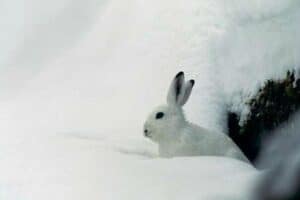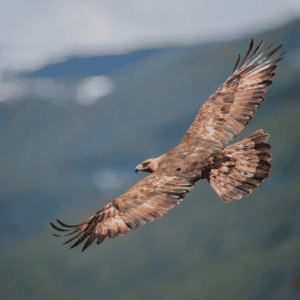Morzine isn’t just a paradise for skiers and snowboarders; it’s also home to a fascinating array of wildlife that thrives in its snowy landscapes. Winter offers a unique opportunity to spot some of these incredible creatures against the pristine backdrop of the Alps. Here’s your guide to the animals you might encounter and tips on how to enjoy wildlife spotting responsibly.
1. Chamois

These agile mountain goats are iconic to the Alps and can often be spotted navigating rocky slopes with ease. In winter, they descend to lower altitudes, making them slightly easier to see. Look out for their distinctive dark coats and curved horns in areas like the Nyon Plateau or near the Ardent Valley.
Tip: Use binoculars to observe chamois from a distance, as they are shy and sensitive to human presence.
2. Alpine Hares

The alpine hare is a master of camouflage, turning white in winter to blend in with the snow. Keep an eye out for these elusive creatures in forested areas or open fields around the Dereche River trail. Their long ears and bounding movements make them a joy to watch if you’re lucky enough to spot one.
3. Golden Eagles

These majestic birds of prey soar high above the Morzine valley, scanning the ground for small mammals. With their impressive wingspan and golden plumage, they are a breathtaking sight. Head to higher altitudes, such as the summit of Pléney or Avoriaz, for a chance to spot them gliding effortlessly through the sky.
4. Red Foxes

Red foxes are often seen in the early morning or late evening, darting through snow-covered meadows or near the edges of the forest. Their vibrant orange coats stand out beautifully against the white snow. The wooded trails near Montriond Lake are a good place to spot them.
5. Ibex

Similar to the chamois, ibex are hardy mountain dwellers known for their impressive horns. They tend to inhabit rocky terrains and are most often seen in quieter, less frequented areas of the Alps. The cliffs near the Col de Joux Plane are a potential hotspot for ibex sightings.
Responsible Wildlife Spotting
While wildlife spotting is an exciting activity, it’s essential to prioritize the well-being of the animals and their habitats. Here are some key guidelines:
– Stay on designated trails: Avoid venturing into off-limit areas to protect fragile ecosystems.
– Keep a safe distance: Use binoculars or cameras with zoom lenses to observe animals without disturbing them.
– Minimise noise: Speak softly and tread lightly to avoid startling wildlife.
– Leave no trace: Take all your rubbish with you and avoid leaving any food behind.